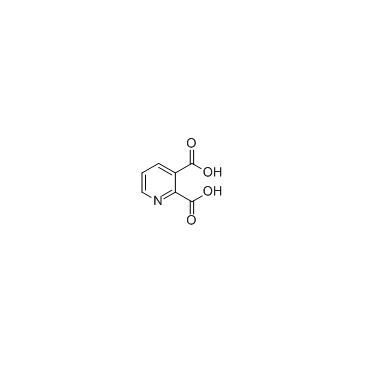吡啶-2,3-二羧酸

吡啶-2,3-二羧酸结构式

|
常用名 | 吡啶-2,3-二羧酸 | 英文名 | Quinolinic acid |
|---|---|---|---|---|
| CAS号 | 89-00-9 | 分子量 | 167.119 | |
| 密度 | 1.6±0.1 g/cm3 | 沸点 | 425.0±30.0 °C at 760 mmHg | |
| 分子式 | C7H5NO4 | 熔点 | 188-190ºC | |
| MSDS | 中文版 美版 | 闪点 | 210.9±24.6 °C | |
| 符号 |

GHS07 |
信号词 | Warning |
|
The CB₁ cannabinoid receptor signals striatal neuroprotection via a PI3K/Akt/mTORC1/BDNF pathway.
Cell Death Differ. 22 , 1618-29, (2015) The CB1 cannabinoid receptor, the main molecular target of endocannabinoids and cannabis active components, is the most abundant G protein-coupled receptor in the mammalian brain. In particular, the CB1 receptor is highly expressed in the basal ganglia, mostl... |
|
|
Activation of the kynurenine pathway and increased production of the excitotoxin quinolinic acid following traumatic brain injury in humans.
J. Neuroinflammation 12 , 110, (2015) During inflammation, the kynurenine pathway (KP) metabolises the essential amino acid tryptophan (TRP) potentially contributing to excitotoxicity via the release of quinolinic acid (QUIN) and 3-hydroxykynurenine (3HK). Despite the importance of excitotoxicity... |
|
|
Age-related reference values for urinary organic acids in a healthy Turkish pediatric population.
Clin. Chem. 40(6) , 862-6, (1994) Organic acid concentrations were quantified by gas chromatography and the individual acids identified by mass spectrometry in urine specimens from a healthy Turkish pediatric population of ages 2 days to 16 years, subdivided into five age groups. We quantifie... |
|
|
Chemical genetics reveals a complex functional ground state of neural stem cells.
Nat. Chem. Biol. 3(5) , 268-273, (2007) The identification of self-renewing and multipotent neural stem cells (NSCs) in the mammalian brain holds promise for the treatment of neurological diseases and has yielded new insight into brain cancer. However, the complete repertoire of signaling pathways ... |
|
|
Metabolomic profiles delineate potential role for sarcosine in prostate cancer progression.
Nature 457(7231) , 910-4, (2009) Multiple, complex molecular events characterize cancer development and progression. Deciphering the molecular networks that distinguish organ-confined disease from metastatic disease may lead to the identification of critical biomarkers for cancer invasion an... |
|
|
Identifying chelators for metalloprotein inhibitors using a fragment-based approach.
J. Med. Chem. 54 , 591-602, (2011) Fragment-based lead design (FBLD) has been used to identify new metal-binding groups for metalloenzyme inhibitors. When screened at 1 mM, a chelator fragment library (CFL-1.1) of 96 compounds produced hit rates ranging from 29% to 43% for five matrix metallop... |
|
|
Automated screening of urine samples for carbohydrates, organic and amino acids after treatment with urease.
J. Chromatogr. A. 562(1-2) , 125-38, (1991) Eighty-five clinical urine samples and nineteen urine samples previously found by other laboratories to suggest genetic metabolic defects were prepared for trimethylsilylation by treatment with urease, followed by azeotropic dehydration. The "Target Analyte S... |
|
|
Effects of translocator protein (18 kDa) ligands on microglial activation and neuronal death in the quinolinic-acid-injected rat striatum.
ACS Chem. Neurosci. 3(2) , 114-9, (2012) There is evidence that excitotoxicity and prolonged microglial activation are involved in neuronal death in neurodegenerative disorders. Activated microglia express various molecules, including the translocator protein 18 kDa (TSPO; formerly known as the peri... |
|
|
Implications for the kynurenine pathway and quinolinic acid in amyotrophic lateral sclerosis.
Neurodegener. Dis. 2(3-4) , 166-76, (2005) The kynurenine pathway (KP) is a major route of L-tryptophan catabolism leading to production of several neurobiologically active molecules. Among them is the excitotoxin quinolinic acid (QUIN) that is known to be involved in the pathogenesis of several major... |
|
|
ECNI GC-MS analysis of picolinic and quinolinic acids and their amides in human plasma, CSF, and brain tissue.
Adv. Exp. Med. Biol. 527 , 705-12, (2003) To study the complex inter-relationships between inflammatory and apoptotic responses and the kynurenine pathway, we have utilized electron-capture negative ion mass spectrometry to develop trace analyses to concurrently quantify nicotinic acid (NIC), picolin... |